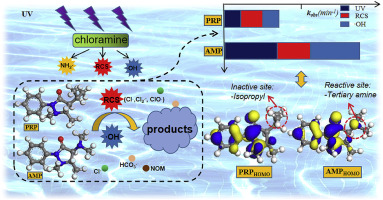当前位置:
X-MOL 学术
›
Water Res.
›
论文详情
Our official English website, www.x-mol.net, welcomes your feedback! (Note: you will need to create a separate account there.)
Degradation behaviors of Isopropylphenazone and Aminopyrine and their genetic toxicity variations during UV/chloramine treatment.
Water Research ( IF 11.4 ) Pub Date : 2019-11-27 , DOI: 10.1016/j.watres.2019.115339 Bingqi Jiang 1 , Yajun Tian 1 , Zichen Zhang 1 , Ze Yin 1 , Li Feng 1 , Yongze Liu 1 , Liqiu Zhang 1
Water Research ( IF 11.4 ) Pub Date : 2019-11-27 , DOI: 10.1016/j.watres.2019.115339 Bingqi Jiang 1 , Yajun Tian 1 , Zichen Zhang 1 , Ze Yin 1 , Li Feng 1 , Yongze Liu 1 , Liqiu Zhang 1
Affiliation

|
Combination of ultraviolet and chloramine (i.e., UV/chloramine) treatment has been attracting increasingly attention in recent years due to its high efficiency in removing trace organic contaminants. This study investigated the degradation behaviors of two pyrazolone pharmaceuticals (i.e., Isopropyl phenazone (PRP) and Aminopyrine (AMP)) and their genetic toxicity variations during UV/chloramine treatment. The results showed that chloramine could hardly degrade PRP and AMP, while UV/chloramine greatly increased the observed first-order rate constant (kobs) of PRP and AMP degradation. The quenching and probe experiments illustrated that the reactive chlorine species (RCS) contributed dominantly to PRP removal, and hydroxyl radical (HO•) was the major contributor to the degradation of AMP, while the reactive amine radicals (RNS) could hardly degrade them. The overall degradation rates of PRP and AMP decreased as pH increased from 6.5 to 10. The kobs of PRP and AMP increased along with NH2Cl dosage increasing and reached a plateau at higher concentrations (0.2-0.5 mM). The present background carbonate (HCO3-, 1-10 mM), chloride (Cl-, 1-10 mM) and natural organic matter (NOM, 5-10 mg-C L-1) exhibited inhibition impacts on PRP and AMP degradation. In addition, the intermediates/products of PRP and AMP were identified and their general degradation pathways were proposed to be hydroxylation, deacetylation, and dephenylization. Specifically, Cl-substitution was inferred during PRP degradation, while demethylation in tertiary amine group was only observed in AMP degradation. These mechanisms including the main reactive sites of PRP and AMP were further confirmed by the frontier orbitals calculation. Moreover, the results of the genetic toxicity according to the micronucleus test of Viciafaba root tip indicated that UV/chloramine treatment could partially reduce the genetic toxicity of PRP and AMP.
中文翻译:

异丙酚和氨基比林的降解行为及其在紫外线/氯胺处理过程中的遗传毒性变化。
近年来,紫外线和氯胺的组合(即紫外线/氯胺)处理由于其去除痕量有机污染物的高效率而受到越来越多的关注。这项研究调查了两种吡唑啉酮药物(即异丙酚菲(PRP)和氨基比林(AMP))的降解行为及其在紫外线/氯胺处理过程中的遗传毒性变化。结果表明,氯胺几乎不能降解PRP和AMP,而UV /氯胺则大大提高了PRP和AMP降解的一级速率常数(kobs)。淬灭和探针实验表明,反应性氯离子(RCS)是PRP去除的主要因素,而羟基自由基(HO•)是AMP降解的主要因素,而反应性胺自由基(RNS)几乎不会降解它们。随着pH从6.5增加到10,PRP和AMP的总降解率降低。随着NH2Cl剂量的增加,PRP和AMP的穗粒增加,并且在较高浓度(0.2-0.5 mM)时达到平稳。目前的背景碳酸盐(HCO3-,1-10 mM),氯化物(Cl-,1-10 mM)和天然有机物(NOM,5-10 mg-C L-1)对PRP和AMP降解表现出抑制作用。此外,鉴定了PRP和AMP的中间体/产物,并提出了它们的一般降解途径为羟基化,脱乙酰化和脱苯化。具体而言,在PRP降解过程中可推断Cl取代,而仅在AMP降解过程中可观察到叔胺基的去甲基化。这些机制包括PRP和AMP的主要反应位点,通过前沿轨道计算得到了进一步证实。此外,根据蚕豆根尖微核试验的遗传毒性结果表明,紫外线/氯胺处理可以部分降低PRP和AMP的遗传毒性。
更新日期:2019-11-28
中文翻译:

异丙酚和氨基比林的降解行为及其在紫外线/氯胺处理过程中的遗传毒性变化。
近年来,紫外线和氯胺的组合(即紫外线/氯胺)处理由于其去除痕量有机污染物的高效率而受到越来越多的关注。这项研究调查了两种吡唑啉酮药物(即异丙酚菲(PRP)和氨基比林(AMP))的降解行为及其在紫外线/氯胺处理过程中的遗传毒性变化。结果表明,氯胺几乎不能降解PRP和AMP,而UV /氯胺则大大提高了PRP和AMP降解的一级速率常数(kobs)。淬灭和探针实验表明,反应性氯离子(RCS)是PRP去除的主要因素,而羟基自由基(HO•)是AMP降解的主要因素,而反应性胺自由基(RNS)几乎不会降解它们。随着pH从6.5增加到10,PRP和AMP的总降解率降低。随着NH2Cl剂量的增加,PRP和AMP的穗粒增加,并且在较高浓度(0.2-0.5 mM)时达到平稳。目前的背景碳酸盐(HCO3-,1-10 mM),氯化物(Cl-,1-10 mM)和天然有机物(NOM,5-10 mg-C L-1)对PRP和AMP降解表现出抑制作用。此外,鉴定了PRP和AMP的中间体/产物,并提出了它们的一般降解途径为羟基化,脱乙酰化和脱苯化。具体而言,在PRP降解过程中可推断Cl取代,而仅在AMP降解过程中可观察到叔胺基的去甲基化。这些机制包括PRP和AMP的主要反应位点,通过前沿轨道计算得到了进一步证实。此外,根据蚕豆根尖微核试验的遗传毒性结果表明,紫外线/氯胺处理可以部分降低PRP和AMP的遗传毒性。







































 京公网安备 11010802027423号
京公网安备 11010802027423号